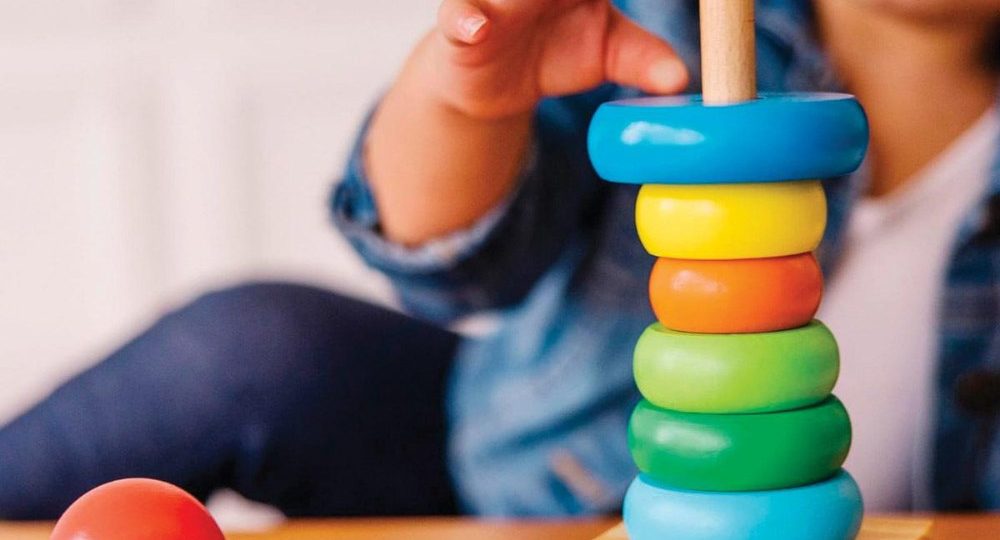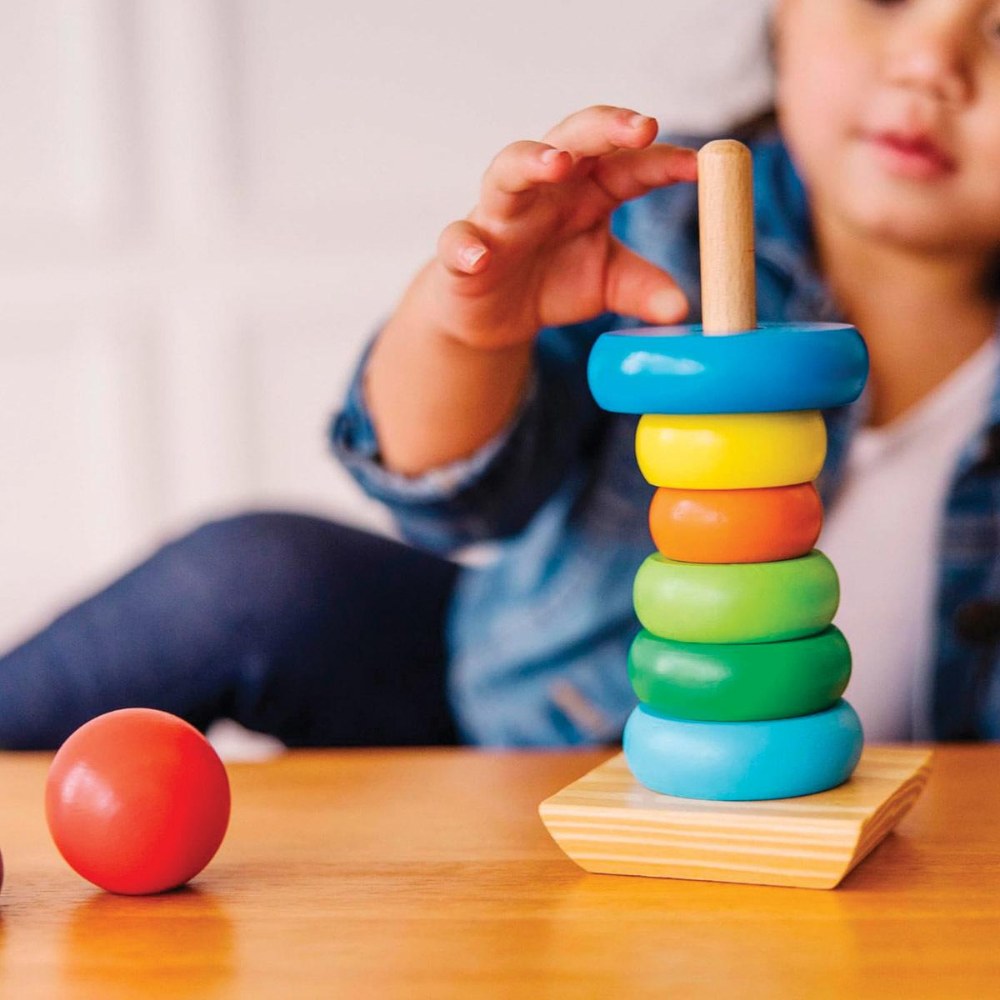
The Innovative Baby Rainbow Stacking Toy for Creative Play
The Importance of Stacking Toys in Early Childhood Development
Stacking toys are a staple in early childhood play. Among these, the baby rainbow stacking toy stands out for its vibrant colors and the developmental benefits it provides. When toddlers engage with these toys, they are not just playing; they are learning. These simple toys can significantly impact their fine motor skills, helping young children to develop their hand-eye coordination. By grasping, stacking, and sorting the colorful arcs or rings, little ones refine their dexterity and control.
Stacking also teaches children about balance and gravity. They learn to understand spatial relationships as they figure out how to stack the pieces without toppling them over. These are foundational concepts in physical science that children grasp intuitively through such play. Moreover, rainbow stacking toys can spark creativity. Children see possibilities for constructing bridges, tunnels, or even pretend play scenes, which enrich their imagination and problem-solving skills.
Furthermore, these toys can be instrumental in developing early color recognition and sorting skills, which are early math concepts. By identifying and matching the different colors of the rainbow stacker, toddlers start recognizing patterns and sequences. This informal play with baby rainbow stacking toys lays the groundwork for formal learning later in life, thereby highlighting their educational importance.
Top Features of Baby Rainbow Stacking Toys
When picking out a baby rainbow stacking toy, it helps to understand its standout features. Here’s what makes these toys special:
- Vibrant Colors: The array of bright hues isn’t just eye-catching; it engages a child’s visual senses and aids in color recognition development.
- Various Shapes and Sizes: From semi-circles to full circles, these toys come in different shapes and sizes. They encourage children to differentiate and match, which boosts cognitive development.
- Textures and Materials: Rainbow stacking toys are available in a variety of textures, such as smooth wood or soft silicone. Each material offers a different tactile experience, aiding sensory development.
- Lightweight Design: They are easy for little hands to hold and manipulate, which is crucial for motor skill development.
- Interlocking Pieces: Some stackers come with interlocking pieces. This feature adds complexity and teaches kids about cause and effect.
Each of these features contributes to the overall development of a child. While keeping a baby entertained, these stacking toys also provide educational benefits that support early childhood growth.
How Baby Rainbow Stacking Toys Promote Cognitive Skills
Baby rainbow stacking toys are more than just colorful playthings. These toys are key in boosting a child’s cognitive development. As children stack and sort the pieces, they exercise their problem-solving skills. They must figure out which piece goes next to maintain balance. This type of play fosters logical thinking and reasoning abilities.
Through playful experimentation, toddlers discover different outcomes of their actions. They learn about size and spatial relationships when they see which pieces fit together. This helps develop their understanding of basic geometry. As they experiment with different configurations, children practice and understand sequence and order, sharpening their memory and recall abilities.
Matching colors of the stacker helps with color recognition. It’s a fun, engaging way to introduce the concept of sorting by attributes. This skill is foundational for math and science learning. Furthermore, children often count pieces as they play, reinforcing number recognition and early arithmetic skills.
Finally, the baby rainbow stacking toy encourages language development. Kids learn new words such as ‘over’, ‘under’, ‘bigger’, and ‘smaller’ as they describe their play. They often talk through their actions, which supports their overall communication skills. In essence, these toys stimulate vital cognitive growth during a fundamental period of a child’s development.
Comparing Different Materials: Wood vs. Silicone Rainbow Stackers
When parents and educators consider a baby rainbow stacking toy, the material is a key factor. Wood and silicone are two popular materials, but they offer different experiences. Here’s a comparison between the two:
Wood Rainbow Stackers
Wooden toys are classic and durable. They often have a timeless appeal and can last for generations. Wood weight gives stability to structures children build. This heaviness helps them learn about balance and effort. Wooden stackers usually have a natural texture, helpful for sensory development. They are also eco-friendly, which appeals to environmentally conscious parents. However, wood can be harder and may not be as forgiving if a child falls or chews on it.
Silicone Rainbow Stackers
Silicone stackers are soft and flexible. They are gentle for teething babies who love to bite their toys. These are usually lighter and easier for tiny hands to grab and hold. The flexibility of silicone allows for unique shapes and can even be squished and squeezed, offering a different tactile experience. Silicone toys are often bright in color and can be easily cleaned, making them quite hygienic. But they may not provide the same level of challenge in stacking as the heavier wood pieces do.
Choosing between wood and silicone rainbow stackers depends on the needs and preferences of the child and parents. Wood offers longevity and a classic feel, while silicone brings softness and versatility. Both materials have their own advantages, so the best choice will align with the desired outcome of the play experience.
Safe Play: Ensuring Non-Toxic Rainbow Stacking Toys for Babies
Safety is crucial when choosing toys for little ones. Babies explore with their hands and mouths, making non-toxic materials a top priority. Here’s how to ensure safe play with baby rainbow stacking toys.
- Check for Safety Certifications: Look for toys that have passed rigorous safety tests. Certifications like ASTM, CE, or EN71 indicate that the toy meets safety standards.
- Non-Toxic Materials: Ensure the toy is made from materials free of harmful chemicals like BPA, phthalates, and lead. Often, manufacturers will label their products as non-toxic.
- Choose Reputable Brands: Trusted brands are more likely to follow safety regulations. Research brands that specialize in making safe baby toys.
- Read Reviews and Ratings: Other parents’ experiences can be invaluable. Read what they have to say about the toy’s safety and quality.
- Inspect for Choking Hazards: Before giving the toy to your child, examine it for small parts or pieces that could be a choking hazard.
- Maintenance and Cleaning: Opt for stackers that are easy to clean. Toys should withstand regular disinfection without deteriorating.
By focusing on safe play, you protect your baby’s health while they enjoy their baby rainbow stacking toy. Keeping these criteria in mind helps ensure you’re providing a safe and educational environment for your child’s playtime.
Age-Appropriate Designs of Rainbow Stacking Toys
When searching for the ideal baby rainbow stacking toy, considering the age-range is essential. Here are key aspects to look for:
- Size and Proportions: For very young infants, larger pieces are safer. They prevent choking hazards.
- Complexity: Simple sets with a few pieces suit younger babies. Older children may enjoy more complex shapes.
- Interaction Levels: High-contrast colors and simple designs are best for newborns. Older toddlers can handle detailed and varied hues.
- Educational Elements: Basic stacking toys are great for starters. Advanced options that include numbers and letters cater to preschoolers learning to read.
Toys that grow with your child are valuable. Some baby rainbow stacking toys are designed to offer different levels of play as a child matures. A versatile set can start with large, easy-to-stack rings. As the child’s skills develop, they can move on to smaller, more intricate pieces. This adaptive approach ensures that the toy remains engaging and challenging.
Furthermore, safety features must align with the child’s age. Non-removable parts are critical for infants. As kids grow, they can manage removable pieces without risk.
Choose a baby rainbow stacking toy that challenges and nurtures your child’s abilities. With age-appropriate designs, rainbow stackers can provide lasting entertainment and developmental support.
Incorporating Rainbow Stacking Toys into Daily Play Routines
Incorporating a baby rainbow stacking toy into daily routines enriches playtime. Here’s how to make the most of it:
- Set Designated Playtimes: Establish regular times for play. This creates a routine that children look forward to.
- Encourage Self-Directed Play: Let kids explore the toy on their own. This fosters independence and creativity.
- Play Together: Join in on the fun. This teaches children teamwork and social interaction.
- Use Them as Learning Tools: Incorporate learning moments. Identify colors and count the pieces during play.
- Create Challenges: As your child becomes more skilled, encourage them to try more complex structures.
- Rotate Toys: Keep interest alive by rotating the baby rainbow stacking toy with other toys.
By following these steps, rainbow stacking toys stay fresh in a child’s day. They can learn, grow and discover through play every day.
Selecting the Best Baby Rainbow Stacking Toy: Parental Tips
Choosing the right baby rainbow stacking toy involves several considerations. Here are some handy tips for parents:
- Assess the Material: Decide if you prefer the natural feel of wood or the flexibility of silicone. Consider safety, durability, and sensory experience.
- Look for Developmental Features: Pick toys that match your child’s developmental stage. For infants, opt for larger pieces. Older toddlers may benefit from added numbers and letters.
- Check for Safety Standards: Ensure the toy meets high safety standards like ASTM or EN71, and is free from toxic materials.
- Think about Cleanliness: Select stackers that are easy to clean. Toys should resist water and soap to stay hygienic.
- Focus on Educational Value: Choose toys that build cognitive and motor skills. They should encourage learning colors, shapes, and basic math.
- Consider Longevity: Go for stackers that offer different levels of difficulty. This helps the toy remain challenging as your child grows.
- Go Beyond Aesthetics: While colors are attractive, ensure the toy’s design also supports learning and development.
By keeping these tips in mind, you can find the ideal baby rainbow stacking toy that is fun, educational, and safe for your child.


